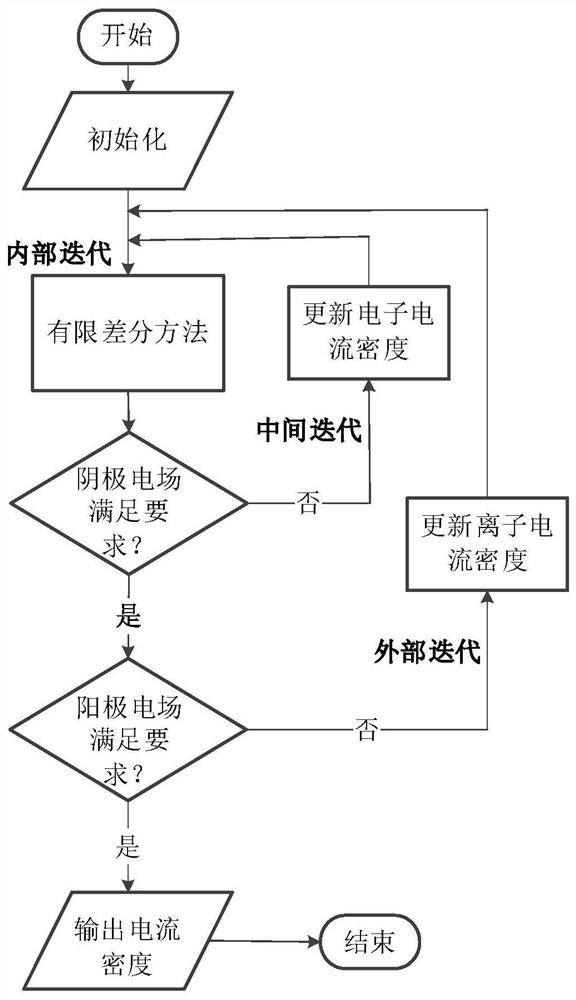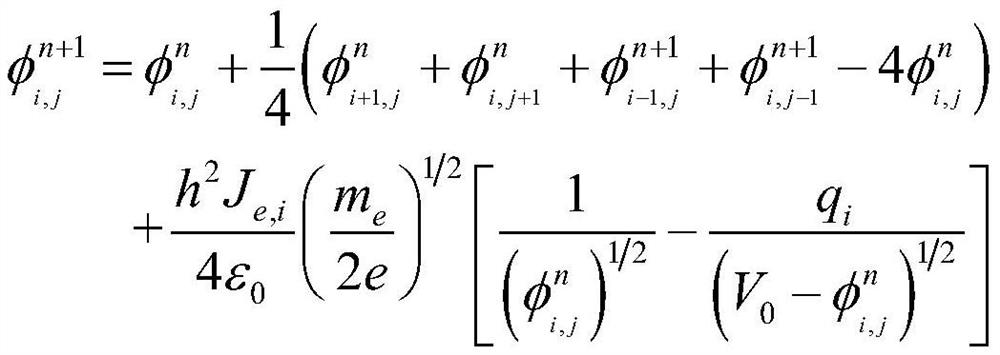Method for synchronously determining boundary electric field and current density of diode
A current density and diode technology, applied in the field of vacuum electronic devices, can solve problems that cannot be solved and are not given, and achieve the effect of solving nonlinear and double boundary problems
- Summary
- Abstract
- Description
- Claims
- Application Information
AI Technical Summary
Problems solved by technology
Method used
Image
Examples
Embodiment 1
[0045] Embodiment 1: In the case where both electron and ion currents are non-uniform under the limited emission area, the method for synchronously determining the boundary electric field and current density of the diode comprises the following steps:
[0046] Step 1. Initial parameter setting
[0047] Given two different vectors of initial value of electron current density and one vector of initial value of ion current density;
[0048] Step 2. Internal iteration
[0049] If the cathode potential of a given diode is zero and the anode potential is V 0 , the charge emission region is located at the center of the boundary, the width is W, and the injected electron current density at the cathode x is J e (x), the implanted ion current density at the anode x is J i (x), the potential at space (x, y) is φ(x, y), then the Poisson equation under the limited emission area can be expressed as:
[0050]
[0051] for|x|≤W / 2
[0052] In the formula, ε 0 、m i , Z, m e , x, y ...
Embodiment 2
[0074] Embodiment 2: In the case where the electron current is non-uniform but the ion current is uniform under the limited emission area, the method for synchronously determining the boundary electric field and current density of the diode comprises the following steps:
[0075] Step 1. Initial parameter setting
[0076] Given two different initial value vectors of electron current density and one initial value vector of ion current density, since the ion current is uniformly distributed, in the emission region, the ion current density is equal to a fixed constant;
[0077] Step 2. Internal iteration
[0078] If the cathode potential of a given diode is zero and the anode potential is V 0 , the charge emission region is located at the center of the boundary, the width is W, and the injected electron current density at the cathode x is J e (x), the implanted ion current density at the anode x is J i (x), the potential at space (x, y) is φ(x, y), then the Poisson equation un...
Embodiment 3
[0102] Embodiment 3: In the case where the electron and ion currents are uniform under the limited emission area, the method for synchronously determining the boundary electric field and current density of the diode comprises the following steps:
[0103] Step 1. Initial parameter setting
[0104] Given two different initial value vectors of electron current density and one initial value vector of ion current density, since the electron and ion currents are uniformly distributed, in the emission region, the electron and ion current densities are both equal to a fixed constant;
[0105] Step 2. Internal iteration
[0106] If the cathode potential of a given diode is zero and the anode potential is V 0 , the charge emission region is located at the center of the boundary, the width is W, and the injected electron current density at the cathode x is J e (x), the implanted ion current density at the anode x is J i (x), the potential at space (x, y) is φ(x, y), then the Poisson ...
PUM
 Login to View More
Login to View More Abstract
Description
Claims
Application Information
 Login to View More
Login to View More - R&D
- Intellectual Property
- Life Sciences
- Materials
- Tech Scout
- Unparalleled Data Quality
- Higher Quality Content
- 60% Fewer Hallucinations
Browse by: Latest US Patents, China's latest patents, Technical Efficacy Thesaurus, Application Domain, Technology Topic, Popular Technical Reports.
© 2025 PatSnap. All rights reserved.Legal|Privacy policy|Modern Slavery Act Transparency Statement|Sitemap|About US| Contact US: help@patsnap.com



